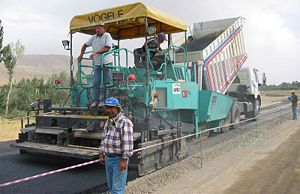Asphalt (paving): Difference between revisions
imported>Milton Beychok m (Added pointer to disambiguation page) |
imported>Milton Beychok m (Similar ==> associated) |
||
| Line 1: | Line 1: | ||
{{subpages}} | {{subpages}} | ||
:''For other articles with this same name or | :''For other articles with this same name or an associated name, please see [[Asphalt (disambiguation)]]'' | ||
{{Image|Asphalt-laying Machine.jpg|right|300px|Asphalt-laying machine paving a road.}} | {{Image|Asphalt-laying Machine.jpg|right|300px|Asphalt-laying machine paving a road.}} | ||
Revision as of 18:45, 5 February 2009
- For other articles with this same name or an associated name, please see Asphalt (disambiguation)
Paving asphalt is a mix of bitumen (petroleum tar), aggregate and additives that is very commonly used as a top layer of paving on existing roads or as a base layer for new roads under construction. A typical paving asphalt consists to 90 to 95 percent by weight of aggregate and 5 to 10 % of bitumen.
Paving asphalt is sometimes referred to as asphalt concrete and, when used to pave airports, may be referred to as tarmac.
Properties
Asphalt is water repellant due to the bitumen which is part of the asphalt mix.
The physical properties are dependent on the temperature of the material, as at high temperatures, asphalt has a very distinctive viscous behaviour. If the temperature of the asphalt is lowered too far, it will solidify and become unusable for paving.
As the physical properties are mainly dependent on the aggregates used, they can vary over a large range. Typical values are:
- thermal conductivity: 0.8 - 1.2 W/mK
- specific heat capacity: 850 - 1050 |J/Kkg
Usage
The main use of asphalt is the creation of pavements like roads or airports. Due to it's physical properties, it can be used as a robust basement as well as a high-load surface.
Manufacturing
The manufacturing of asphalt is done in several steps:
- Predose: Depending on the asphalt recipe, the individual components of the aggregate are weighed. Usually this is done using a belt weigher, as the material has to reach the next step in a continuous flow.
- Drying: In a rotary drying drum, the components of the aggregate are dried at a temperature between 140 and 190 °C. After the drying, the components are sifted and separately stored in several silos.
- Weighing: As the drying can change the previous grain-size distribution curve, a final weighing has to take place before adding the individual aggregate components to the mixer. This also allows for quick changing of the recipe. The binder (asphalt) is kept in heated tanks and added to mixer according to a measured rate of flow.
- Mixing: The mixer can be working either continuously or at intervals. An interval mixer is fed with the aggregates using a charging screw and the binder is synchronously injected into the mixing chamber. For very high volumes, a continuously working mixer is used and it can not be adapted quickly to changing volume and recipe needs.
- Dispatching: The mixed material is stored in a heated silo which usually has several chambers to store different recipes.
Transport
Asphalt has to reach the construction site with a reasonably high temperature as it can not be used when it's too cold due to its physical properties. The transportation has to be set up in a way to ensure the correct temperatures can be maintained until the construction site is reached. For short distances between the asphalt plant and the construction site, ordinary trucks can be used and covered with tarpaulins to maintain the temperatures.
If the ambient temperature is too low or the construction site is too far away to use ordinary trucks and maintain the correct temperatures, then special trucks have to be used.
